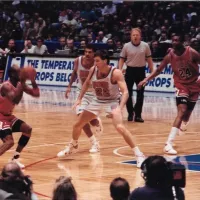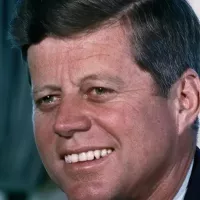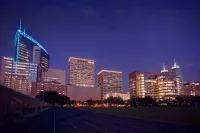Dallas is a major city in Texas, United States, and the ninth-most populous city in the U.S. With a population of 1.3 million, it serves as the core of the Dallas–Fort Worth metroplex, the fourth-largest metropolitan area in the country with 7.5 million residents. It's the biggest inland metropolitan area in the U.S. without a navigable connection to the sea. Dallas is the county seat of Dallas County, and its area extends into several other counties in North Texas.
1900: Dallas cotton market
By 1900, Dallas was the largest inland cotton market in the world, becoming a leader in cotton gin machinery manufacturing.
1901: First branch of Dallas Public Library opens
In 1901, the Dallas Public Library system, created by the Dallas Federation of Women's Clubs, opened its first branch due to fundraising efforts and a grant from Andrew Carnegie.
1903: Annexation of Oak Cliff
In 1903, Oak Cliff, once a separate city founded in the mid-1800s, was annexed by Dallas.
July 4, 1906: Lake Cliff Park opens
On July 4, 1906, Lake Cliff Park opened and was called "the Southwest's Greatest Playground".
1907: Construction of the Dallas Firefighter's Museum
In 1907, the Dallas Firefighter's Museum was built along Parry Avenue near Fair Park.
1909: Construction of the Praetorian Building
In 1909, the Praetorian Building was constructed in Dallas. At 15 stories high, it was among the first skyscrapers west of the Mississippi River and the tallest building in Texas for some time, marking Dallas' prominence as a city.
1910: Lynching of Allen Brooks
In 1910, a white mob lynched Allen Brooks, a black man accused of rape. Brooks was tortured and hanged from a decorative archway at Main and Akard in downtown Dallas, and thousands of Dallasites came to gawk at the scene.
1913: Turtle Creek Parkway park built
In 1913, Turtle Creek Parkway park was built as a 23.7-acre linear park.
1914: Federal Reserve District seat
In 1914, Dallas was selected as the seat of the Eleventh Federal Reserve District.
1921: Licensing of WRR-AM
In 1921, WRR-AM was licensed and became the oldest commercially operated radio station in Texas and the second-oldest in the United States.
1921: Mexican President visits Little Mexico
In 1921, the Mexican president Álvaro Obregón visited Downtown Dallas's Mexican Park in Little Mexico.
1925: Texas cotton production
By 1925, Texas produced more than 1/3 of the nation's cotton crop, with 31% of Texas cotton produced within a 100-mile radius of Dallas.
1930: Dallas's White Population
In 1930, Dallas's population was predominantly White (non-Hispanic Whites made up 82.8% of the population).
1931: Opening of Highland Park Village
In 1931, Highland Park Village, the second shopping center ever built in the United States, opened in Dallas.
1935: Dallas purchased 36 acres from John Cole
In 1935, Dallas purchased 36 acres from John Cole's estate to develop Reverchon Park.
1936: Fair Park built for Texas Centennial Exposition
In 1936, Fair Park was built for the Texas Centennial Exposition world's fair.
1953: Exhibition game for the New York Giants and the Cleveland Indians
In 1953, Reverchon Park was host to a exhibition game for the New York Giants and the Cleveland Indians.
1959: Lake Cliff Park pool demolished after polio scare
In 1959, the pool at Lake Cliff Park, Dallas's first municipal pool, was demolished after a polio scare.
November 22, 1963: Assassination of John F. Kennedy
On November 22, 1963, United States President John F. Kennedy was assassinated on Elm Street in Downtown Dallas. He was pronounced dead at Dallas Parkland Memorial Hospital shortly after the shooting.
1963: Kennedy assassination
According to the Warren Commission Report, in 1963 Lee Harvey Oswald shot and killed President John F. Kennedy from the Texas School Book Depository.
1968: Dallas Tornado play in North American Soccer League
From 1968, the Dallas Tornado played in the North American Soccer League.
1969: Anita N. Martinez became the first Latin American councilwoman
In 1969, Anita N. Martínez became the first Latin American to sit as a councilwoman in Dallas's city council.
1971: Frozen margarita machine
In 1971, restaurateur Mariano Martinez invented the Frozen margarita machine.
1972: Texas Rangers relocate from Washington D.C.
In 1972, the Texas Rangers relocated from Washington D.C.
1980: Dallas Mavericks join the league
In 1980, the Dallas Mavericks joined the league as an expansion team.
1980: Record High Temperature Set
On June 26 and 27, 1980, during the Heat Wave of 1980, Dallas/Fort Worth International Airport recorded the all-time record high temperature of 113 °F (45 °C).
1981: Dallas Tornado play in North American Soccer League
Until 1981, the Dallas Tornado played in the North American Soccer League.
1984: Original Dallas Sidekicks operated
From 1984, the original Dallas Sidekicks operated.
December 8, 1991: Belo Purchases and Closes the Dallas Times Herald
On December 8, 1991, Belo purchased the Dallas Times Herald, the Morning News' major competitor, and closed the paper down the next day.
1993: Dallas Stars relocate from Minnesota
In 1993, the Dallas Stars moved to North Texas, relocating from Minnesota where they were known as the Minnesota North Stars.
1996: DART Begins Operating Light Rail
In 1996, Dallas Area Rapid Transit (DART) began operating the first light rail system in Texas.
1997: FC Dallas win Lamar Hunt U.S. Open Cup
In 1997, FC Dallas won the Lamar Hunt U.S. Open Cup.
1998: Dallas Magpies founded
In 1998, the Dallas Magpies, an Australian rules football team, was founded.
1999: Fewest Freezing Nights Record Begins
The winter of 1999-2000 held the record for the fewest freezing nights with 14.
2000: Fewest Freezing Nights Record Ends
The winter of 1999-2000 held the record for the fewest freezing nights with 14.
2002: City's total budget
In the 2002, the city's total budget (the sum of operating and capital budgets) was $1.7 billion.
2003: DISD as of 2003
As of 2003, DISD has the majority of K–12 students in the city of Dallas, and a proportionately larger number of students who are not non-Hispanic white.
2003: HBC Acquired by Univision
In 2003, Hispanic Broadcasting Corporation (HBC), the largest company in the Spanish-language radio station business, was acquired by Univision and became Univision Radio Inc.
2003: Royce Hanson's Statement on School Districts
In 2003, Royce Hanson identified Plano, Richardson, and Wilmer-Hutchins school districts as the most significant ones with students in Dallas who were not part of Dallas ISD.
2003: Median Worker Income
In 2003-2007, male full-time workers had a median income of $32,265 versus $32,402 for female full-time workers in Dallas.
2003: City's total budget
In the 2003, the city's total budget (the sum of operating and capital budgets) was $1.9 billion.
2004: John Kerry in the 2004 presidential election
In the 2004 U.S. presidential election, 57% of Dallas voters voted for John Kerry.
2004: City's total budget
In the 2004, the city's total budget (the sum of operating and capital budgets) was $2.0 billion.
2004: Original Dallas Sidekicks close
Until 2004, the original Dallas Sidekicks operated.
September 2005: Mark Cuban land purchase
In September 2005, Dallas Mavericks owner Mark Cuban purchased land along Lamar Street near Cedars Station.
2005: Perot Museum of Nature and Science design
In 2005, Thom Mayne and his firm Morphosis Architects designed the Perot Museum of Nature and Science in Downtown Dallas.
2005: Closure of Wilmer-Hutchins Independent School District
In 2005, the Wilmer-Hutchins Independent School District (WHISD) was shut down for the 2005-2006 school year, and students began attending other Dallas ISD schools.
2005: City's total budget
In the 2005, the city's total budget (the sum of operating and capital budgets) was $2.2 billion.
2006: Consolidation of WHISD into Dallas ISD
In 2006, following the closure of Wilmer-Hutchins Independent School District (WHISD), the Texas Education Agency consolidated WHISD into Dallas ISD.
2006: Good-Latimer tunnel demolition
In late 2006, the Good-Latimer tunnel was torn down to accommodate the construction of a light rail line through the site.
2006: City's total budget
In the 2006, the city's total budget (the sum of operating and capital budgets) was $2.2 billion.
2007: Comerica relocation
In 2007, Comerica relocated its national headquarters to Downtown Dallas from Detroit.
2007: Median House Price in 2007
Per 2007's survey, the median price for a house in Dallas was $129,600.
2008: Lupe Valdez re-elected Dallas County Sheriff
In 2008, Lupe Valdez, an open lesbian, won re-election as Dallas County Sheriff.
2008: Trinity River Audubon Center opens
In 2008, the Trinity River Audubon Center opened, serving as a gateway to trails and nature-viewing activities and being the first LEED-certified building by the City of Dallas Parks and Recreation Department.
August 2009: Regional Transportation Council Seeks Federal Stimulus for Trolley Project
In August 2009, the Regional Transportation Council agreed to seek $96 million in federal stimulus dollars for a trolley project in Dallas and Fort Worth.
2009: Commuting Statistics in Dallas
In 2009, 78.5% of Dallas commuters drove to work alone, 10.7% carpooled, 3.9% used transit, 1.9% walked, and .1% cycled.
2009: Allen Americans Founded
In 2009, The Allen Americans were founded in the Central Hockey League(CHL).
2009: Cowboys relocate to new stadium
In 2009, the Dallas Cowboys relocated to their new 80,000-seat stadium in Arlington.
2009: Meadows Museum partnership
In 2009, the Meadows Museum at Southern Methodist University joined up with Madrid's Prado Museum for a three-year partnership.
2009: Cotton Bowl Classic game moves to AT&T Stadium
Through its 2009 game, the college Cotton Bowl Classic football game was played at the Cotton Bowl, after which it moved to AT&T Stadium.
February 11, 2010: Record Snowfall
On February 11, 2010, Dallas experienced a record snowfall of 11.2 inches (28 cm).
February 2010: Dallas Awarded TIGER Grant for Streetcar Project
In February 2010, Dallas was awarded a $23 million TIGER grant towards the $58 million Dallas Streetcar Project.
December 6, 2010: Opening of the First Stage of the Orange Line
On December 6, 2010, the first stage of the Orange Line opened, extending its west end from Bachman to Belt Line Station in Irving.
2010: Dallas's Population
According to the 2010 U.S. census, 50.7% of the population was White (28.8% non-Hispanic White), 24.8% was Black or African American, 0.7% American Indian and Alaska Native, 2.9% Asian, and 2.6% from two or more races; 42.4% of the total population was of Hispanic or Latino American origin.
2010: Influx of Black Residents
Between 2010 and 2020, the Dallas area had the second-most new Black and African American residents only behind the Atlanta area.
2010: Household Demographics
In 2010, Dallas had 458,057 households, 33.7% of which had one or more people under 18 years of age, and 17.6% had one or more people who were 65 years of age or older. The median age was 31.8 years, with the population being equally male and female.
2010: Texas Rangers win American League pennant
In 2010, the Texas Rangers won the American League pennant.
2011: Texas Rangers win American League pennant
In 2011, the Texas Rangers won the American League pennant.
2011: New Year's Eve celebration attendance record
New Year's Eve 2011 set a new record of 32,000 people in attendance at the annual New Year's Eve celebration in AT&T Plaza.
November 6, 2012: Russian-speaking population estimate
On November 6, 2012, it was estimated that the Dallas–Fort-Worth metroplex had 70,000 Russian-speakers, primarily immigrants from the former Soviet Bloc, including Russians, Russian Jews, Ukrainians, Belarusians, Moldavians, Uzbek, and Kirghiz. The Russian-speaking population was noted to be growing due to "American husbands-Russian wives." The community also had its own newspaper, The Dallas Telegraph.
2012: Allen Americans win CHL championship
In 2012, Allen Americans won their first CHL championship
2012: Dallas Sidekicks (2012) founded
In 2012, the Dallas Sidekicks (2012), an American professional indoor soccer team, were founded.
2012: Iranian American population in Plano-Richardson
In 2012, the Plano-Richardson area had an estimated 30,000 Iranian Americans.
2012: Obama received 57% of Dallas County voters in the 2012 elections
In the 2012 elections, Barack Obama received 57% of Dallas County voters.
December 2013: Foreign-born population in Dallas and Tarrant Counties
According to U.S. Census Bureau data released in December 2013, 23 percent of Dallas County residents were foreign-born, while 16 percent of Tarrant County residents were foreign-born.
2013: Parks and Recreation Department Update
As of 2013, the City of Dallas managed 477 athletic fields.
2013: Allen Americans win CHL championship
In 2013, Allen Americans won their second CHL championship.
August 2014: Opening of the Second and Final Phase of the Orange Line
In August 2014, the second and final phase of the Orange Line opened, providing DFW Airport with rail service. DFW Airport Terminal A station became the terminus for the Orange Line and connects Skylink.
September 2014: USS Dallas decommissioning
In September 2014, the Los Angeles-class submarine USS Dallas was planned to become a museum ship near the Trinity River after her decommissioning, but this has since been delayed.
2014: Christianity prevalence study
According to a 2014 study by the Pew Research Center, Christianity was the most prevalently practiced religion in Dallas and the wider metropolitan area (78%).
2014: Evangelical Protestantism
According to the Pew Research Center, evangelical Protestantism constituted the largest form of Protestantism in the Dallas area as of 2014.
2014: Allen Americans win ECHL championship
In 2014, Allen Americans won their first ECHL championship.
2014: Dallas area hosts Final Four of NCAA Men's Division I Basketball Tournament
In 2014, the Dallas area hosted the Final Four of the NCAA Men's Division I Basketball Tournament at AT&T Stadium.
2014: Oil price drop
Starting in mid-2014, a sudden drop in the price of oil began.
2015: Percentage of Households without a Car
In 2015, 10.2 percent of Dallas households lacked a car.
2015: Allen Americans win ECHL championship
In 2015, Allen Americans won their second ECHL championship.
2015: Commuting Statistics in Dallas
In 2015, American Community Survey estimated that 75.4% of Dallas commuters drove alone, 12.8% carpooled, 3.5% used transit, 1.9% walked and 0.2% cycled.
2015: Continued economic growth
In 2015, Dallas and the metropolitan region continued to see strong demand for housing, apartment and office leasing, shopping center space, warehouse and industrial space with overall job growth remaining very robust, despite an oil price downturn.
2015: Residential real estate boom
Since 2015, single-family home sales, both pre-owned and new construction, along with home price appreciation, were leading the nation in Dallas and the greater metro area.
July 7, 2016: Black Lives Matter Protest Shooting
On July 7, 2016, a Black Lives Matter protest in Downtown Dallas was targeted by a gunman, Micah Xavier Johnson, who killed five police officers and injured nine others, along with two bystanders. Johnson was killed by a robot-delivered bomb inside Dallas College El Centro Campus after negotiations failed.
October 2016: Jacobs Engineering relocation
In October 2016, Jacobs Engineering, one of the world's largest engineering companies, relocated from Pasadena, California to Downtown Dallas.
2016: Percentage of Households without a Car
In 2016, 9.1 percent of Dallas households lacked a car, and Dallas averaged 1.59 cars per household.
2016: FC Dallas win Lamar Hunt U.S. Open Cup and Supporters' Shield
In 2016, FC Dallas won the Lamar Hunt U.S. Open Cup and the Supporters' Shield.
2016: FC Dallas win Lamar Hunt U.S. Open Cup
In 2016, FC Dallas won the Lamar Hunt U.S. Open Cup.
2016: Plano's Chinese American population
In 2016, Plano, a northern suburb of Dallas, had the 6th largest Chinese American population among large-sized cities in the United States.
2016: Dallas Wings relocate to The Metroplex
In 2016, the Dallas Wings relocated to The Metroplex from Tulsa.
2016: Hillary Clinton in the 2016 presidential election
In the 2016 presidential election, 67% of voters supporting Hillary Clinton.
2017: American Community Survey Estimates
In 2017, the American Community Survey estimates among the demographic 35.5% were Mexican, 0.6% Puerto Rican, 0.4% Cuban, and 5.4% other Hispanic or Latino.
2017: City's total budget
In the 2017, the city's total budget (the sum of operating and capital budgets) was $3.3 billion.
2018: Housing Rates
In 2018, the owner-occupied housing rate in Dallas was 40.2%, and the renter-occupied housing rate was 59.8%.
2018: City's total budget
In the 2018, the city's total budget (the sum of operating and capital budgets) was $3.3 billion.
2018: Dallas's foreign-born population
The 2018 census estimates determined that the city of Dallas's foreign-born population consisted of 25.4% naturalized citizens and 74.6% non-citizens.
November 2019: Master plan presented to revitalize Fair Park
In November 2019, consultants presented to the public a master plan to revitalize the Fair Park area.
2019: Population Estimates
At the U.S. Census Bureau's 2019 estimates, 29.1% of Dallas's population were non-Hispanic White, 24.3% Black and African American, 0.3% American Indian or Alaska Native, 3.7% Asian, and 1.4% from two or more races. Hispanic or Latino Americans of any race made up 41.2% of the estimated population.
2020: Christianity prevalence study
According to the Public Religion Research Institute's 2020 study, Christianity was the most prevalently practiced religion in Dallas and the wider metropolitan area (77%).
2020: Dallas Population
At the 2020 United States census, the city of Dallas had 1,304,379 residents.
2020: Influx of Black Residents
Between 2010 and 2020, the Dallas area had the second-most new Black and African American residents only behind the Atlanta area.
2020: Largest Ethnic Group
By 2020, Hispanic or Latino Americans of any race continued to constitute the largest ethnic group in the city proper.
2020: Household Demographics
In 2020, Dallas had 524,498 households, with 137,523 having children under 18. The average household size was 2.52, and the average family size was 3.41.
2020: Dallas Jackals announced as new franchise
In 2020, Major League Rugby announced the Dallas Jackals as a new franchise.
2020: Median House Price in 2020
In 2020, the median income for a household in Dallas was $54,747 and the median house price was $252,300.
2020: Joe Biden in the 2020 presidential election
In the 2020 presidential election, 69% of voters supporting Joe Biden.
February 2021: North American Winter Storm Impacts Horticulture
During the February 2021 North American winter storm, many cold-sensitive plants such as Washingtonia filifera and Washingtonia robusta palms died off in Dallas.
February 2021: North American Winter Storm
In February 2021, Dallas experienced a North American winter storm.
February 16, 2021: Temperature during North American Winter Storm
On February 16, 2021, during the February 2021 North American winter storm, the temperature at Dallas/Fort Worth International Airport reached −2 °F (−19 °C).
2021: McKesson on Fortune 500 list
In 2021, McKesson, located in Irving, was listed at number seven overall on the Fortune 500 list.
July 1, 2022: Dallas Population Decrease
As of July 1, 2022, the U.S. Census Bureau estimates that Dallas lost 4,835 people since the 2020 census, leaving the city with a population of 1,299,544.
2022: Fortune 500 companies in Dallas and DFW
According to Fortune Magazine's 2022 annual list, the city of Dallas had 11 Fortune 500 companies, and the DFW region as a whole had 23. Dallas–Fort Worth represented the second-largest concentration of Fortune 500 headquarters in Texas and fourth-largest in the United States.
2022: Dallas murder rate decreased
By 2022 the Dallas murder rate decreased to 214.
2022: Homeless Count
The 2022 Point-In-Time Homeless Count found there were 4,410 homeless people in Dallas, with approximately 31% found on the streets or in other places not meant for human habitation.
May 2023: Dallas Trinity FC founded
In May 2023, Dallas Trinity FC was founded by the Neil family and managed by Chris Petrucelli.
2023: Dallas murder rate increased
In 2023 the Dallas murder rate increased to 246.
2023: Texas Rangers win American League pennant and World Series
In 2023, the Texas Rangers won the American League pennant and the World Series.
2023: Percentage of Households without a Car
In 2023, the percentage of Dallas households without a car decreased to 8.7 percent.
2023: Eric Johnson switches parties to Republican
Since 2023, Dallas has been the largest city in the United States with a Republican mayor after Eric Johnson switched parties after winning re-election.
August 2024: Dallas Trinity FC kick off its inaugural season
In August 2024, Dallas Trinity FC kicked off its inaugural season when they played Tampa Bay Sun FC, ending in a 1 v 1 tie. Following this match was two very significant matches for the club, the friendly match and home opener. The club played their friendly match vs FC Barcelona Femení where they lost 0-6 and the club's official home match was against DC Power FC where they tied 1-1.
2024: Kamala Harris in the 2024 presidential election
In the 2024 presidential election, over 60% of Dallas voters supporting Kamala Harris.
2026: Arlington to host FIFA World Cup matches
In 2026, the Dallas Cowboys' stadium in Arlington is set to host the most matches during the FIFA World Cup.
Mentioned in this timeline

Basketball is a team sport played on a rectangular court...

Donald John Trump is an American politician media personality and...

John F Kennedy JFK was the th U S President...

George W Bush the rd U S President - is...

Hillary Diane Rodham Clinton is an American politician lawyer and...

Barack Obama the th U S President - was the...
Trending

Nathaniel Jasper Tank Dell Jr is a professional American football wide receiver currently playing for the Houston Texans in the...

8 months ago Multiple Shootings in Houston Leave Several Wounded and Three Dead Overnight
2 months ago Mack Hollins' Halloween Bishop Costume Causes Frenzy Before Patriots-Browns Game

6 months ago Kai Cenat: Twitch Star's Brand Launches in Target, Co-owns Mansion with Tony Parker.

2 months ago Rose Bowl Sues UCLA over Alleged Attempt to Move Games to SoFi Stadium.

9 months ago Calipari's Departure Impacts Kentucky, Arkansas, BYU, Texas Tech Game Clock Malfunction in Sweet 16
Popular

XXXTentacion born Jahseh Dwayne Ricardo Onfroy was a controversial yet...

Stranger Things created by the Duffer Brothers is a popular...

Candace Owens is an American conservative political commentator and author...
The Kennedy Center Honors are annual awards recognizing individuals and...

William Franklin Graham III commonly known as Franklin Graham is...

Ben Shapiro is a prominent American conservative political commentator media...
